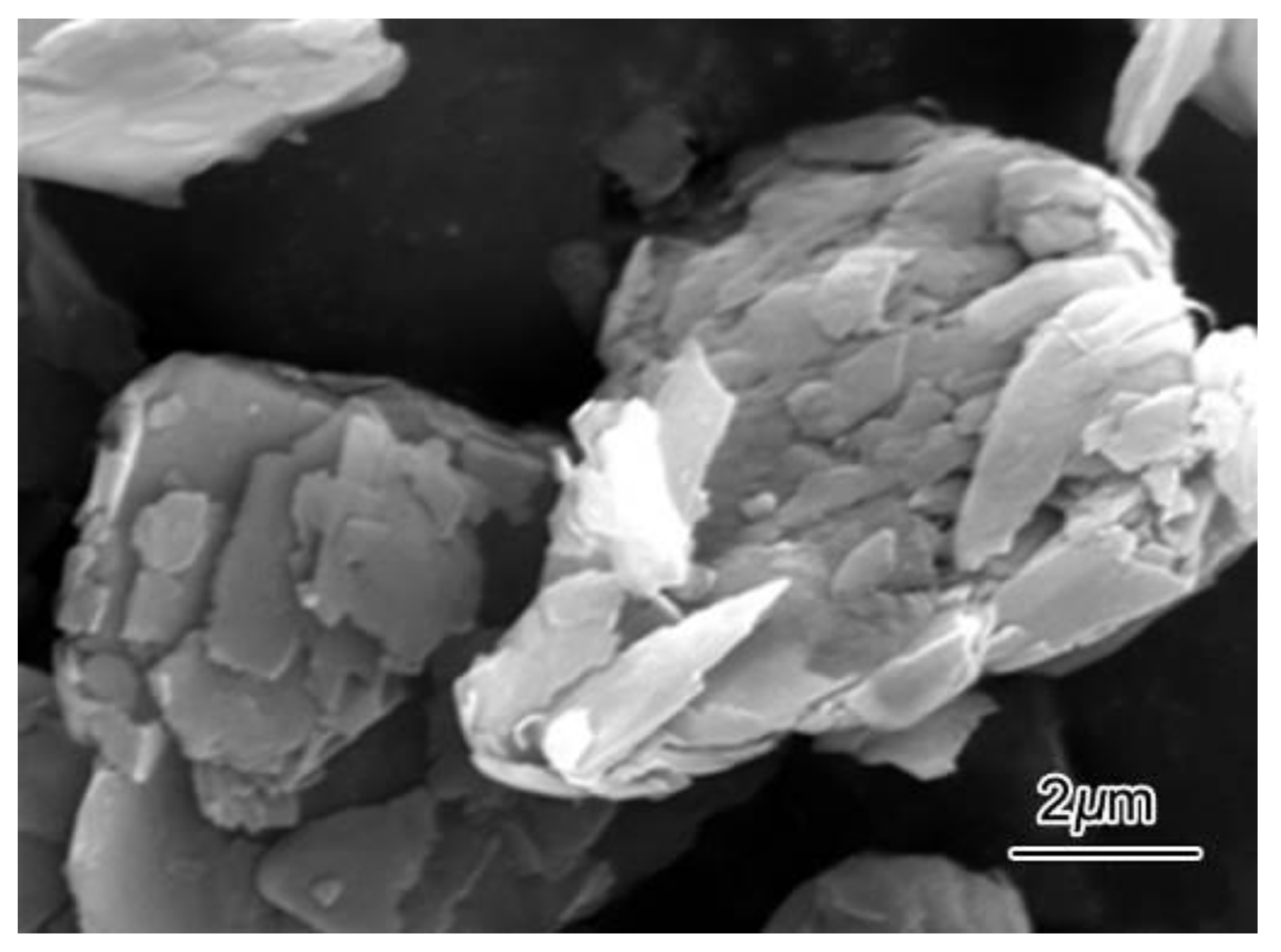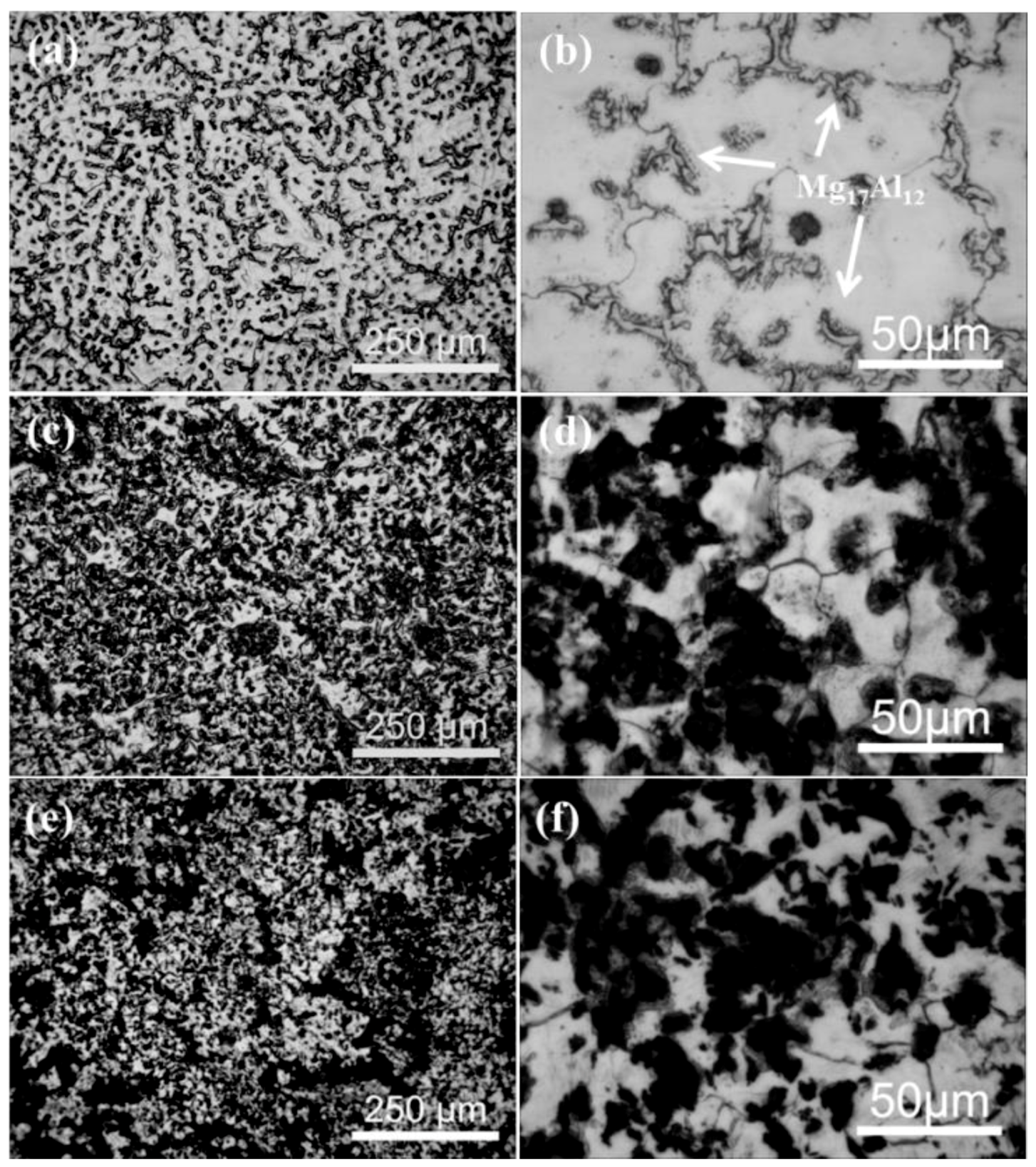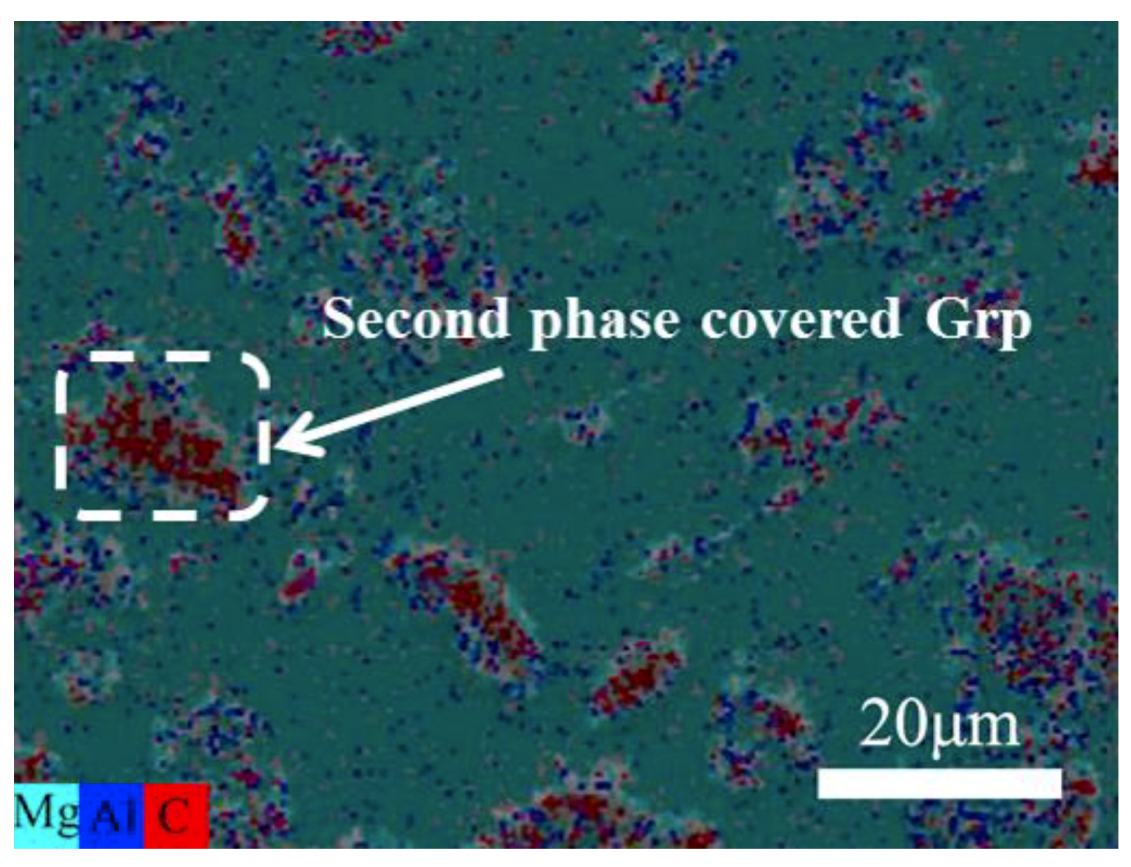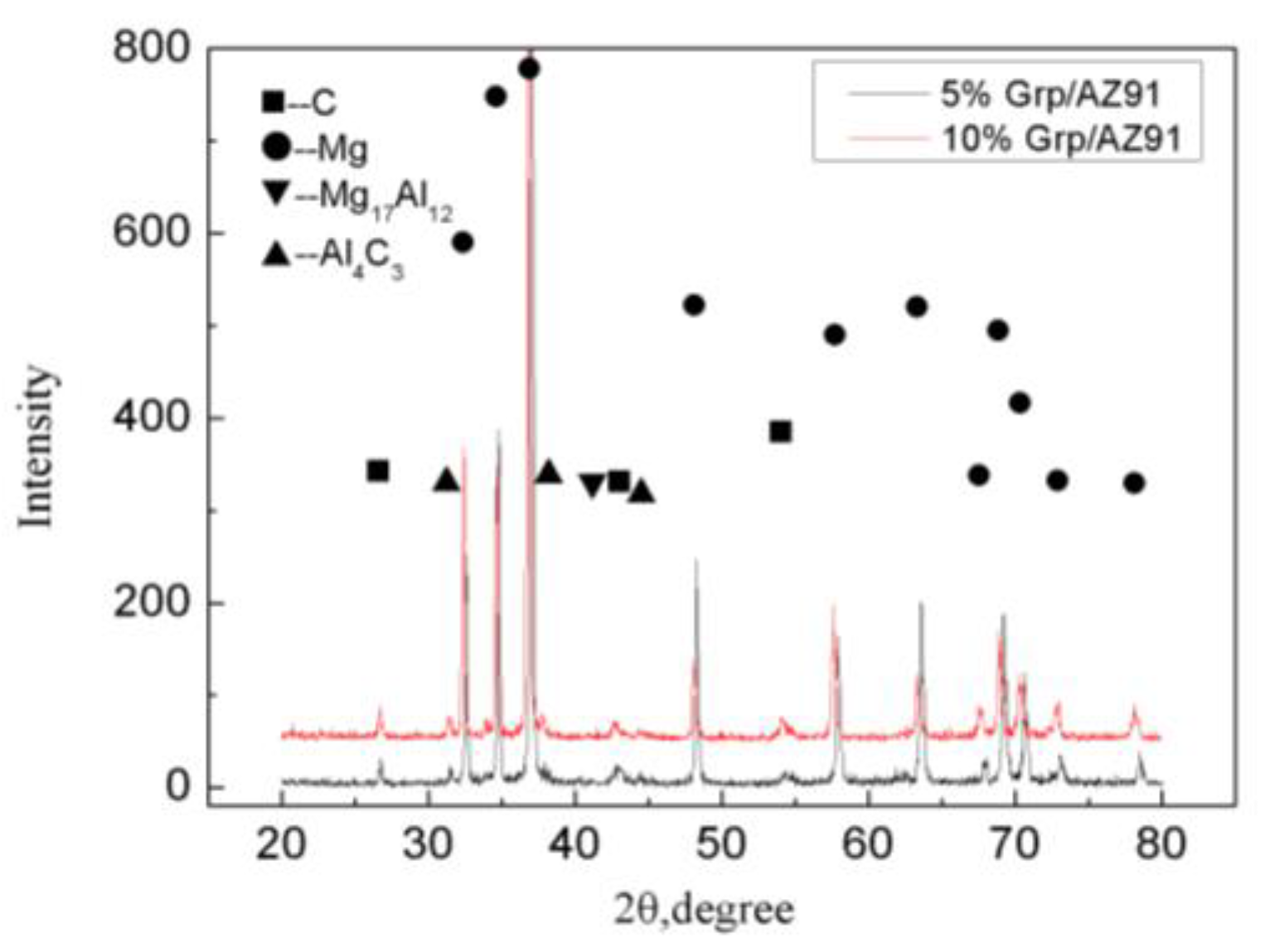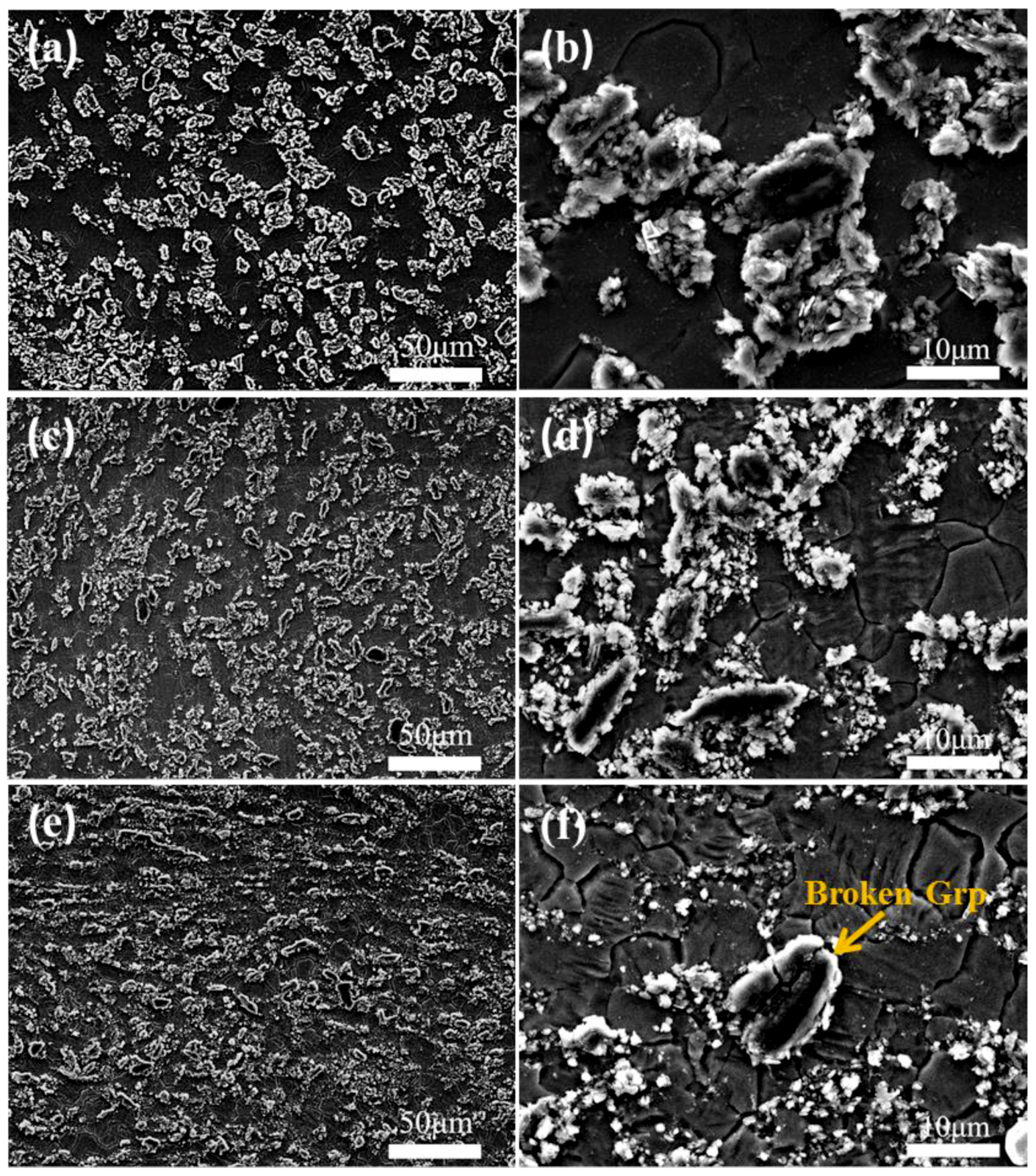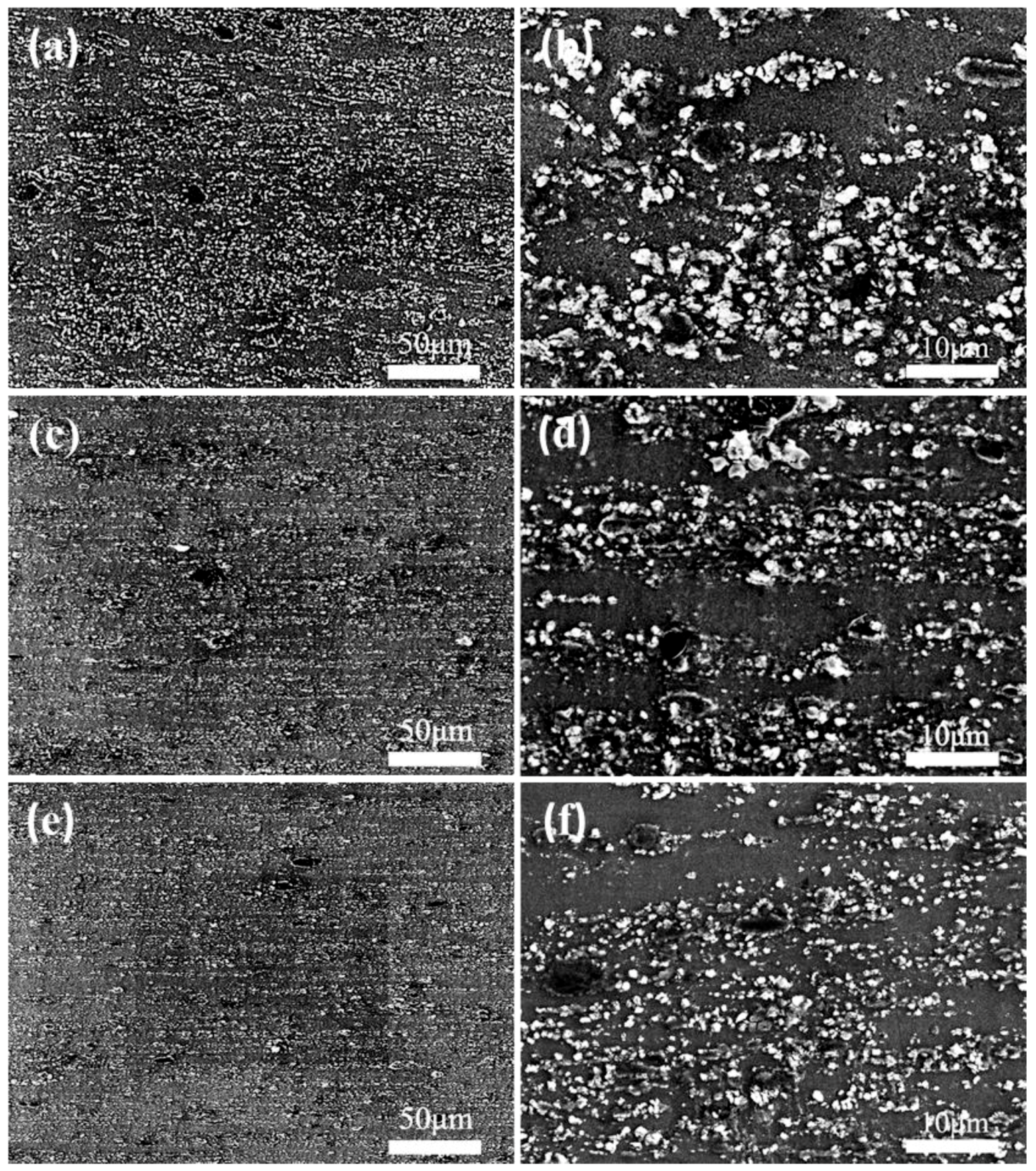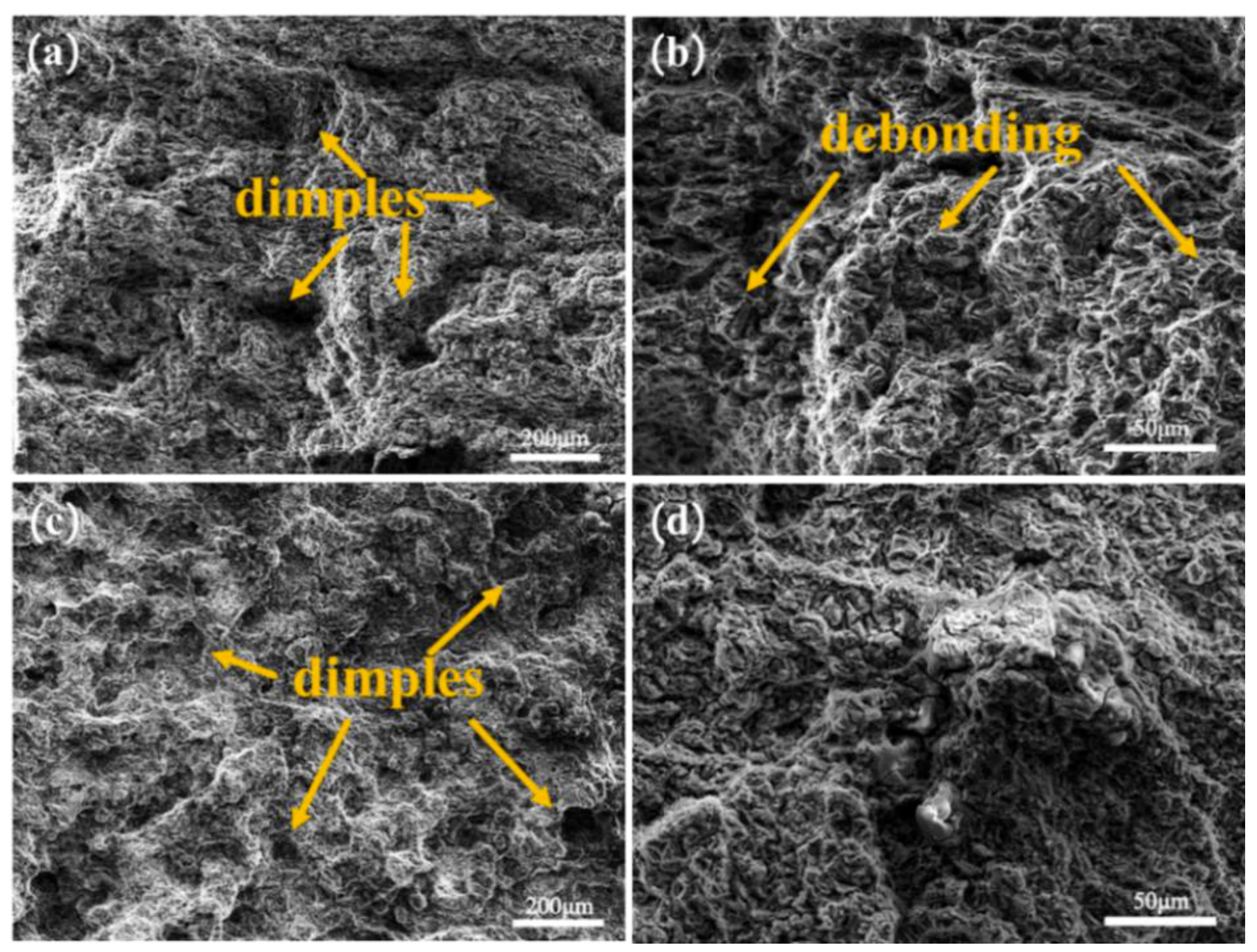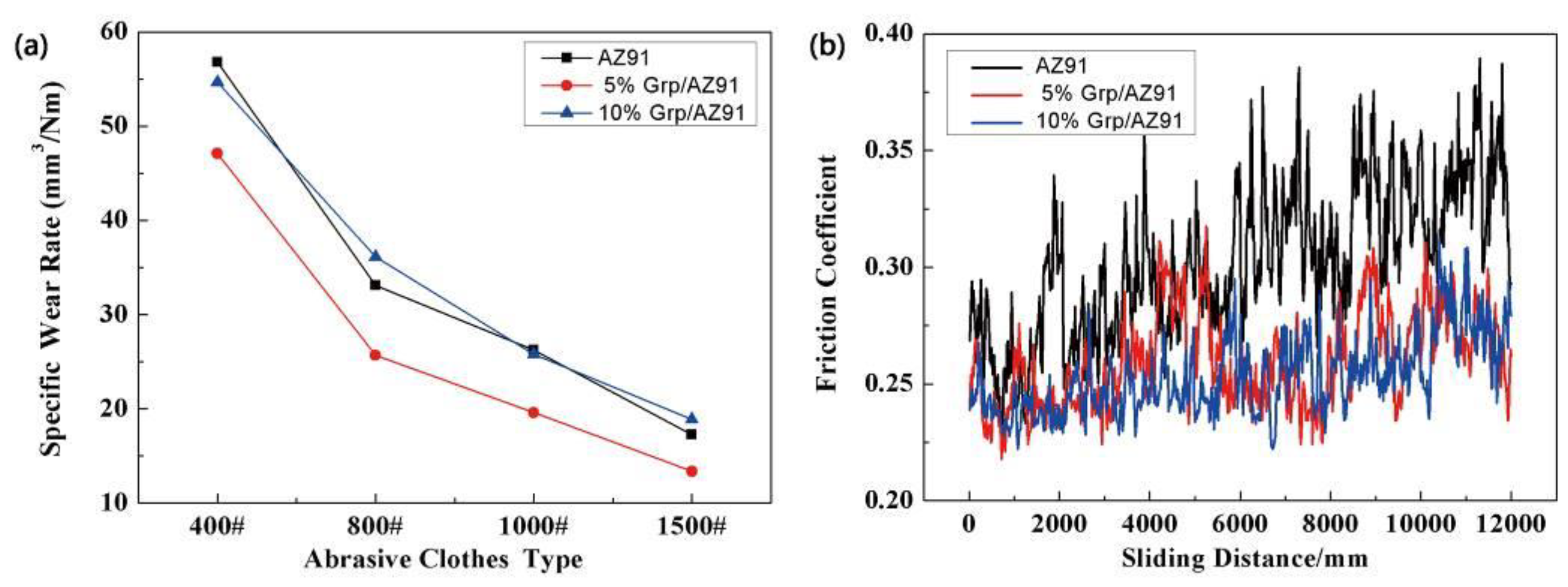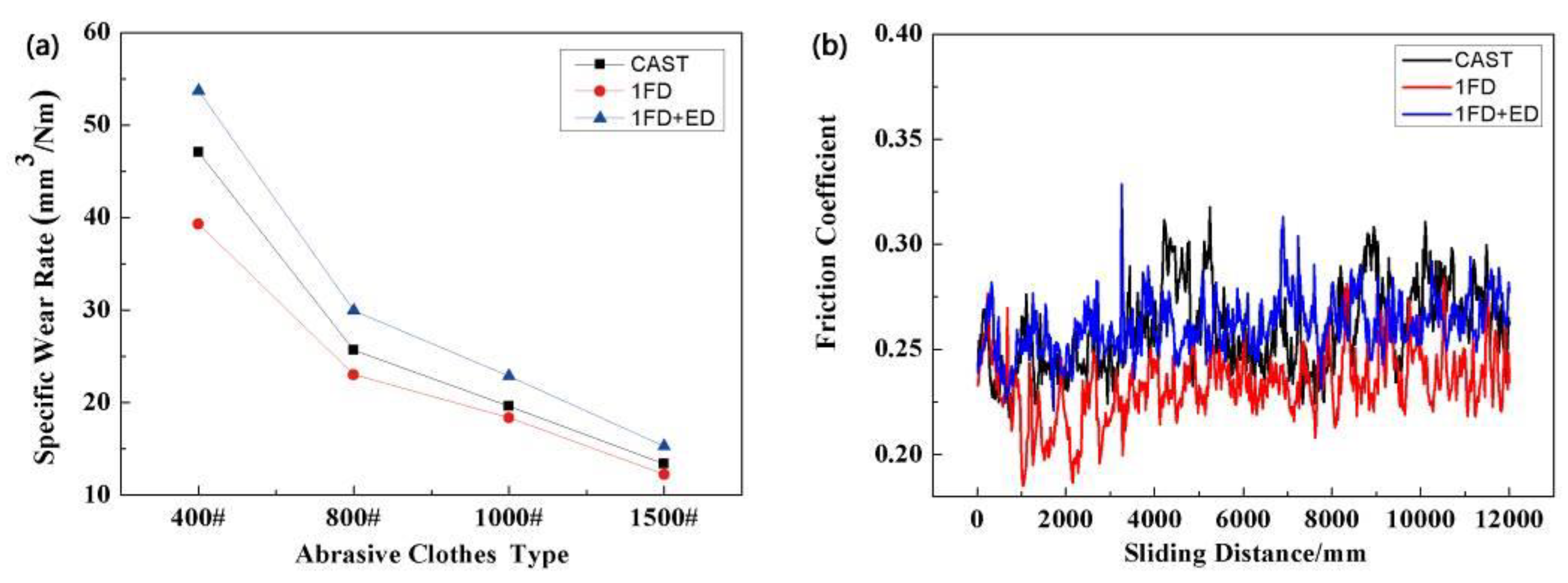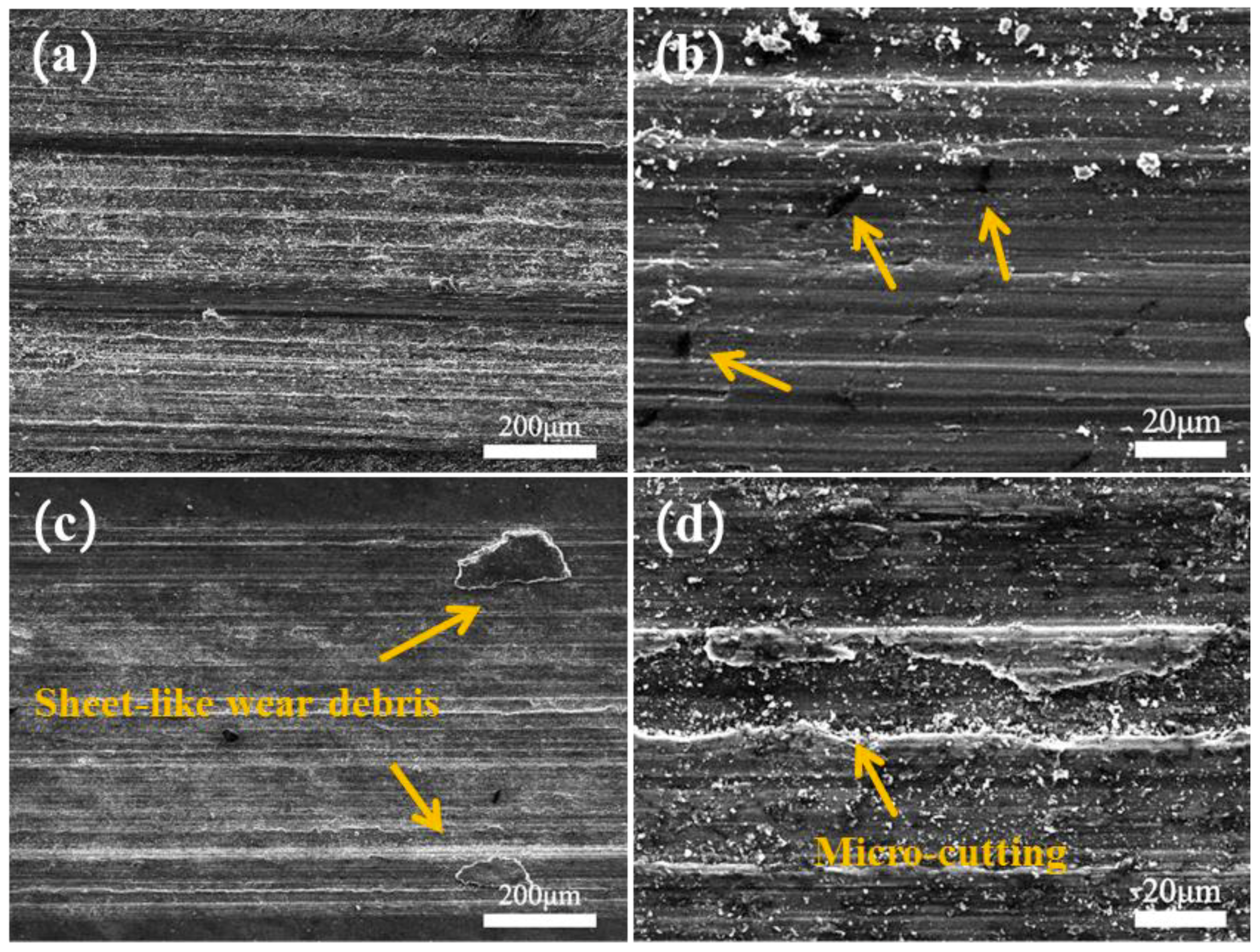3.1. As-cast Microstructure of the AZ91 Alloy and the Grp/AZ91 Composites
Figure 2 shows the optical microstructure of the as-cast AZ91 alloy and the Grp/AZ91 composite. As can be seen from
Figure 2a,b, the grains of the as-cast AZ91 alloys were large in size. The second phase, i.e., the Mg
17Al
12 phase, was mainly precipitated reticularly along the grain boundary, and a small part of it was distributed in the matrix in granular form. This distribution pattern along the grain boundary impaired the mechanical properties of the matrix. Due to the high energy at the grain boundary, the Al element in the AZ91 alloy in the form of a solid solution tended to be concentrated here, to form the Mg
17Al
12 phase [
26,
27]. After the addition of 5 vol % of Grp, as shown in
Figure 2c,d, the grain size of the Grp/AZ91 composites decreased, and the distribution of Grp was fairly uniform. The precipitates (Mg
17Al
12) at the grain boundaries almost entirely disappeared. The introduction of the 5 vol % Grp effectively improved the distribution of the second phase in the AZ91 composite.
Figure 2e,f show the Grp/AZ91 composites with 10 vol % Grp added. The grain size of the 5% Grp/AZ91 composite further decreased, but to just a small degree. These suggested that the addition of Grp to 10 vol % did not make the distribution of the second phase change significantly, though slight particle agglomeration was observed. The OM images of the as-cast AZ91 alloy, 5% Grp/AZ91 composites, and 10% Grp/AZ91 composites, were statistically analyzed by Image-Pro Plus, and the average grain sizes of the three composites were 95.1 μm, 79.3 μm, and 72.4 μm, respectively. As the volume fraction of Grp increased, the grain size was gradually refined. This is because a higher graphite content produced a greater number of heterogeneous nuclear particles in the matrix composite, thereby increasing the nucleation rate and leading to grain refinement, which was conducive to the improvement of the mechanical properties of the composite.
Figure 3 shows the surface scanning of the as-cast 5% Grp/AZ91 composites. It shows that most of the second phases containing Al accumulated at the interface between the graphite particles and the matrix. This indicated that the addition of Grp effectively inhibited the precipitation of the Mg
17Al
12 phase at the grain boundary. From the X-ray diffraction (XRD) analysis of the as-cast 5% Grp/AZ91 composites and the 10% Grp/AZ91 composites (
Figure 4), the diffraction peak of the Mg
17Al
12 phase in the as-cast 5% Grp/AZ91composites was small in size, consistent with the analysis of the microstructure. The appearance of the diffraction peak of the Mg
17Al
12 phase in the 10% Grp/AZ91 composites revealed that the addition of Grp was harmful to the microstructure and properties of the composite. Moreover, besides the Mg
17Al
12 phase, the Al
4C
3 phases were found in the two composites.
The reason for the appearance of Al
4C
3 phase in the composite was the occurrence of the interface reaction. The study of Wang et al. [
28] found that Al powder and C powder could react rapidly above 520 °C to form the Al
4C
3 phase. Lu et al. [
29] found the formation of Al
4C
3 when conducting heat preservation on the graphite particle reinforced the aluminum matrix composite at 630 °C. In this test, the casting temperature may exceed 700 °C, and the AZ91 composite contained 9.3 wt % of Al, and the AI could react with Grp to form the Al
4C
3 phase in the process of casting. Based on this, the addition of 5% Grp was beneficial for the microstructure and properties of the AZ91 composite.
3.2. Effect of Multiple Forging on Microstructure of Grp/AZ91 Composites
On the basis of the casting composites, considering that the mechanical properties of the as-cast composites were not ideal, it was necessary to conduct thermal deformation to improve their properties. Thermal deformation can not only eliminate casting defects, but also refine the grains, making the distribution of the reinforcing phases in the composite more uniform.
Figure 5 shows the SEM image of the 5% Grp/AZ91 composites after MDF under different forging deformation times (FD) (1FD, 3FD, 6FD represent one, three and six MDFs respectively). It can be seen from
Figure 5a that the Grp distribution in the 5% Grp/AZ91 composites were more uniform after forging once, and the slight particle agglomeration phenomenon in the as-cast composite was eliminated, and the average size of Grp was reduced.
Figure 5c,d are SEM images of 5% Grp/AZ91 after forging three times, and the Grp was more broken and refined than Grp of the composite after forging once.
Figure 5e,f are SEM images of 5% Grp/AZ91 after forging six times. The size of Grp further decreased, and obvious cracks could be observed inside the Grp under high-magnification SEM. This was because after forging six times, high stress was accumulated on Grp, while Grp itself had relatively low strength, leading to the rupture of Grp.
The size of Grp was statistically analyzed by Image-Pro Plus software, as shown in
Table 3. For the size values in
Table 3, the number before ‘±’ is the average value, and the number after ‘±’ is the standard deviation. The standard deviation was larger, with the grain size being more uneven. The size of Grp decreased with the increase of the forging deformation frequency, which was consistent with the results of the microstructure observed in SEM. Wu et al. [
30,
31] studied the hot extrusion of a 50 μm Grp-reinforced magnesium matrix composite, and found that the aspect ratio of Grp increased monotonously with the increase of extrusion temperature. In this test, there was no obvious increase in the aspect ratio of Grp, but Grp breakage occurred. This is due to the following reasons: (1) The extrusion temperature was lower than the extrusion temperature in the test of Wu, which is not conducive to the relative slip of the graphite sheet; (2) Grp is small in size and prone to plastic flow with the matrix during extrusion; (3) the Al
4C
3 phase with higher hardness wrapped at the Grp interface did not match Grp deformation during extrusion, and as a result, the Grp broke into finer particles. Combined with the above analysis, we could see that the change of Grp size was caused by particle breakage during deformation. The average size of the particles was smaller than the deviation, which indicated that there were more small particles and fewer large ones.
The grain sizes of the 5% Grp/AZ91 composites were statistically analyzed by Image-Pro Plus software, and the results are shown in
Table 4. It can be seen that after forging once, the grain size was obviously refined. Compared with the grain size of the as-cast composite, the degree of recrystallization was relatively complete, and there were no coarse grains that had not yet undergone recrystallization. Nie et al. [
32] reported that after multi-directional forging at 400 °C, there were still many areas in the microstructure of the AZ91 composite without recrystallization, and this indicated that the graphite particles could promote the occurrence of recrystallization. The change of grain size was caused by dynamic recrystallization (DRX). During the forging process, the occurrence of DRX resulted in grain refinement and uneven grain size. With the increase of forging passes, the degree of DRX and the uniformity of grain size increased, and so the standard deviation decreased. The same was true for Grp size. With the increase of forging passes, the average particle size decreased and the standard deviation decreased. After forging three times, the grain size of the composite decreased slightly, but this increased after forging six times. This was because, on the one hand, with the increase of the number of forges, the initial microstructure before forging was more uniform, the grains and graphite particles were more refined, and there were more grain boundaries and interfaces, so that the recrystallization nucleation rate of the next forging increased. On the other hand, with the increase of forging frequency, the amount of strain accumulating in the composite increased, and the recrystallization driving force increased accordingly. The combined action of the recrystallization nucleation rate and driving force made the grain sizes of the 5% Grp/AZ91 composites first decrease, and then increase with the increase of forging rounds.
3.3. Effect of Multi-Step Deformation on the Microstructure of Grp/AZ91 Composites
Figure 6 shows the SEM image of the microstructure of the 5% Grp/AZ91 composites after multi-step deformation. 1FD+ED, 3FD+ED, 6FD+ED represent one MDF plus extrusion once, three MDFs plus extrusion once and six MDFs plus extrusion once, respectively.It can be seen from
Figure 6a,b that compared with the composites after forging once, the Grp of the 5% Grp/AZ91 composites after forging plus extrusion once (1FD+ED) was distributed along the extrusion direction, and its size also significantly decreased.
Figure 6c–f shows SEM images of the microstructures of the 5% Grp/AZ91 composites after forging plus extrusion three times and forging plus extrusion six times, respectively. It can be seen that compared with the 5% Grp/AZ91 composite after forging plus extrusion once, there was no significant change in the distribution and size of Grp of the 5% Grp/AZ91 composites after forging plus extrusion three times or forging plus extrusion six times.
The size of Grp in the composite after multi-step deformation was statistically analyzed by Image-Pro Plus software. The results are shown in
Table 5. It can be found that with the increase of the forging times before extrusion, there was no obvious change in the size of Grp in the composite after extrusion. This was because, compared with extrusion deformation in multi-directional forging, extrusion deformation with an extrusion ratio of 16:1 was obviously more severe, having a stronger crushing effect on Grp. As a result, composites with different initial sizes of Grp shared nearly the same sizes of Grp after hot extrusion.
The grain sizes of the composites after multi-step deformation were statistically analyzed, and the results are shown in
Table 6. It can be found that the grain sizes of the composites after multi-step deformation were obviously refined, compared with the grain sizes of the composites after multi-directional forging. This was because the recrystallization grains were refined due to large deformation during hot extrusion, the large driving force of recrystallization nucleation, and the large increase of the nucleation rate. In addition, with the increase of the forging frequency before extrusion, the grain size of the composite after extrusion decreased slightly. This was because the composite after forging was homogenized before extrusion, eliminating all possible influences of grain size and the Mg
17Al
12 phase. Before hot extrusion, there was only a difference in the size of Grp between composites with different forging times, and with the increase of forging times before extrusion, Grp was smaller in size and larger in relative quantity, which could obviously improve the recrystallization nucleation rate. Therefore, the composite after forging plus extrusion six times contained the finest grain.
3.5. Effect of Multi-Step Deformation on the Mechanical Properties of the Grp/AZ91 Composites
Table 8 shows the mechanical properties of the 5% Grp/AZ91 composites after multi-step deformation. It can be found that the mechanical properties of the composite after multi-step deformation were superior to the mechanical properties of the composite after multi-directional forging. Compared with the composites after forging once, the yield strength, tensile strength, and elongation of the composite after forging plus one round of extrusion were increased by 23%, 30%, and 65%, respectively. This was attributed to the more uniform microstructure and the fine recrystallization grain of the 5% Grp/AZ91 composites after multi-step deformation. By a longitudinal comparison of the mechanical properties of the three different composites after multi-step deformation in
Table 7, it can be found that with the increase of forging frequency before extrusion, the yield strength, tensile strength, and elongation of the composites increased slightly, but the increase was not obvious. Compared with the composites after forging plus one round of extrusion, the yield strength, tensile strength, and elongation of the composite after forging plus extrusion six times were increased by 3%, 3%, and 23%, respectively. This may be attributed to the relatively fine grain size of the composite after forging plus extrusion six times.
Figure 7 shows the SEM images of the fracture of the 5% Grp/AZ91 composites after forging once, and the 5% Grp/AZ91 composites after forging plus extrusion once. From
Figure 7a, it can be observed that the dimples on the matrix after forging once were large in size and small in quantity, which indicates that there was a small strain on the fracture surface, and that it had a typical brittle fracture morphology. In the high-magnification SEM image (
Figure 7b), many Grp-sized pits and protrusions could be found, and this indicates that interface debonding occurred between the Grp and the matrix, and that the crack extended along the Grp interface, leading to fracture on the composite. From
Figure 7c, it can be found that the dimples on the matrix after extrusion were small in size and large in quantity, indicating that much plastic deformation occurred before fracture. No obvious interface debonding was observed in the high-magnification SEM image (
Figure 7d), indicating that the bonding strength of Grp against the matrix was increased after extrusion, and that the crack tended to be generated from the inside of the graphite particles, and that the cracking spread during subsequent stretching.
3.6. Wear resistance Analysis of Grp/AZ91 Composites
Figure 8a shows the change of wear rate of the as-cast AZ91 alloy and Grp/AZ91 composites, with the decrease of the abrasive cloth grit. With the decrease of the abrasive cloth grit, the wear rate of the AZ91 alloy and the Grp/AZ91 composites decreased. This was because, when the abrasive cloth grit was larger in size, the real contact area was smaller. As a result, plastic deformation more easily occurred on the soft matrix, and it was not conducive to the formation of the graphite lubrication layer. Compared with the as-cast AZ91 alloy, the wear rate of the Grp/AZ91 composite significantly decreased after adding 5 vol % of Grp. This was due to the following reasons: (1) After the addition of Grp, the hardness of the composite was improved, and the ability to resist microcutting was enhanced; (2) after extrusion from the matrix, Grp spread to the wear surface to form a graphite-rich surface film, preventing severe adhesion and ploughing. As the volume fraction of Grp increased to 10 vol %, the wear rate of the composite increased. This was because the continued addition of Grp did not further increase the hardness of the composite, and the interface between Grp and the matrix was usually the source of the crack. These greatly reduced the plasticity of the composite itself, and decreased the ability of the composite surface to resist spalling and wear. Under the action of cyclic load, the shear deformation of the surface layer accumulated continuously, and the shear band at a certain depth below the surface layer expanded into a crack. The expansion of the crack in the depth direction was hindered by the normal stress parallel to the surface, and at this depth, the crack expanded in a direction that was parallel to the surface, until it reached the wear surface.
Figure 8b is the curve of the friction coefficient of the as-cast AZ91 alloy and Grp/AZ91 composites over time. It shows that the friction coefficient of the as-cast AZ91 alloy obviously increased with the increase of friction time. This was because, in the absence of effective lubrication, the rough peak on the surface of the softer composite gradually disappeared with the increase of friction time, and the friction surface became flatter, so that the real contact area between the AZ91 alloy and the mating surface increased, and the friction coefficient increased. After the addition of 5 vol % of Grp, the friction coefficient of the Grp/AZ91 composites decreases significantly, indicating that the introduction of graphite particles could actually reduce the friction coefficient and improve the lubrication condition of the friction pair.
The average friction coefficient of the Grp/AZ91 composites slight decreased when the volume fraction of Grp increased to 10 vol %. This was due to the following reasons: (1) The lubrication conditions of friction pairs were improved and the friction coefficient was reduced with the increase of Grp. (2) As mentioned above, the ability of material surface to resist exfoliation and wear decreased, and the real contact area of material and spouse surface increased with the increase of Grp, resulting in the increase of the friction coefficient. As a result of these two aspects, the average friction coefficient of the composites decreases slightly when the Grp content increases from 5% to 10%.
Rohatgi et al. studied graphite reinforced composites with different matrices [
33]. The results showed that the friction coefficient of the composites decreased with the increase of graphite content when the content of graphite particles was less than 20 vol %. The friction coefficient of the composites was stable at 0.2, which was about the friction coefficient of graphite when the content of graphite particles was more than 20 vol %. In this experiment, the addition of Grp was not up to 20%, as mentioned in Rohatgi’s research, so the friction coefficient decreases with the addition of Grp. However, the friction coefficient decreased obviously when the content of Grp reached 5%. The decreasing degree of the friction coefficient became weaker when the content of Grp reached 10%.
Through the above analysis, it was found that the 5% Grp/AZ91 composites had the best performance. In order to further study the effects of different thermal deformation modes on the wear resistance of composites, the 5% Grp/AZ91 composites after forging once, and 5% Grp/AZ91 composites after forging plus extrusion once were selected, and their wear rate and friction coefficients were tested. The results were compared with those of the as-cast Grp/AZ91 composites.
Figure 9a shows the wear rate of the 5% Grp/AZ91 composites under different abrasive cloth models. It shows that as the abrasive cloth grit decreased, the wear rate of the as-cast Grp/AZ91 composites, the 5% Grp/AZ91 composites after forging once, and the 5% Grp/AZ91 composites after forging plus extrusion once all decreased. This was because the smaller the size of the abrasive cloth grit, the less likely it was to scratch the surface of the specimen.
By a longitudinal comparison of the three composites at different states, it was found that the wear rates of the 5% Grp/AZ91 composites after forging once decreased slightly, while the wear rates of the composites increased after hot extrusion. It could be seen that the change rule of the wear resistances of the 5% Grp/AZ91 composites after thermal deformation was contrary to the change trend of the mechanical properties of the composite. In this test, the wear resistances were the worst in the as-extruded composites with the highest hardnesses, and the reasons for these phenomena were: (1) The decrease in the size of Grp. After hot extrusion, the size of Grp decreased obviously, while a smaller Grp tended to peel off with the matrix during ploughing, and it was wrapped in wear debris, making it difficult to play a role in lubrication. After hot extrusion, the bonding strength of Grp to the matrix increased, and this also limited the lubrication of Grp. (2) The increase in the temperature of the wear surface. In the test, there were small loads and small sliding speeds, but there might still be a high temperature on the friction surface due to the wear of the abrasive cloths, thus weakening the hardness improvement caused by the work hardening and the fine-grain strengthening of the surface of the composite. (3) The distribution orientation of Grp in the 5% Grp/AZ91 composites after forging plus one round of extrusion was perpendicular to the friction pair. The vertical orientation of Grp in the composite after hot extrusion led to the fact that the actual volume fraction of the particles near the surface of the composite was lower than the overall volume fraction of the composite. Therefore, in conclusion, compared with the as-cast composite, the improvement of the wear resistance of the composite after forging once could not be attributed to significant decrease in the size of Grp after forging, and a significant improvement in the average microhardness and plasticity. The decrease in the wear resistance of the composite after forging plus extrusion once was due to a combination of a significant decrease in the size of Grp, high temperature on the wear surface, and the vertical orientation distribution of Grp after extrusion.
Figure 9b is the curve of the friction coefficient of the as-cast Grp/AZ91 composites and 5% Grp/AZ91 composites after thermal deformation. It shows that the friction coefficient of the 5% Grp/AZ91 composites after forging once was decreased, compared with the friction coefficient of the as-cast composites, and this was due to slight adhesive wear on the surface of the as-cast composite. After hot extrusion, the friction coefficient of the 5% Grp/AZ91 composites increased significantly. This can be attributed to the small Grp in the as-extruded 5% Grp/AZ91. The small Grp did not play a role in lubrication after matrix peeling, and the content of Grp near the surface was lower than the actual content because of the vertical orientation.
Figure 10 shows the SEM morphology of the wear surface of 5% Grp/AZ91 after thermal deformation. From
Figure 10a, it can be found that the composites after forging once were relatively flat over the whole wear surface, and there was an obvious ploughing morphology. The exposure of Grp could be observed from high-magnification SEM (
Figure 10b) of the composite, and this indicated that the wear surface was well-lubricated. Therefore, the wear mechanism of the 5% Grp/AZ91 composites after forging once was mainly due to ploughing wear.
Figure 10c shows that large flaky wear debris was evident on the wear surface of 5% Grp/AZ91 after forging plus extrusion once, which could be called wedge formation, and deep micro-cutting grooves were found in the high-magnification SEM (
Figure 10d). Compared with the situation where composites on both sides of ploughing were pushed by the ploughing direct cutting of the composite by micro-cutting, this makes the wear of micro-cutting greater and the friction coefficient higher. The main wear mechanisms of the as-extruded 5% Grp/AZ91 composites were wedge formation and micro-cutting wear.
